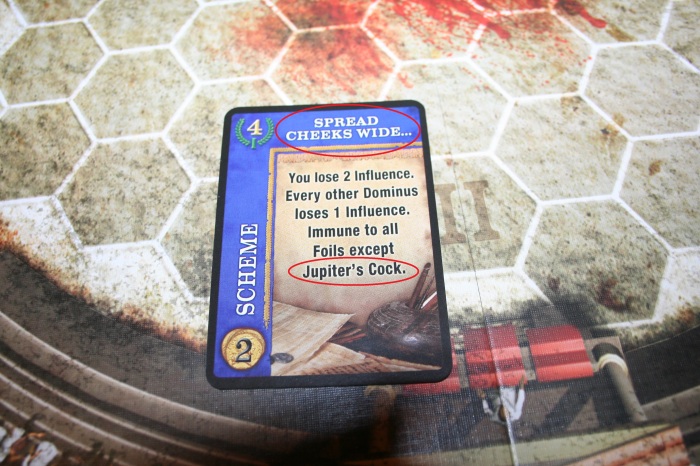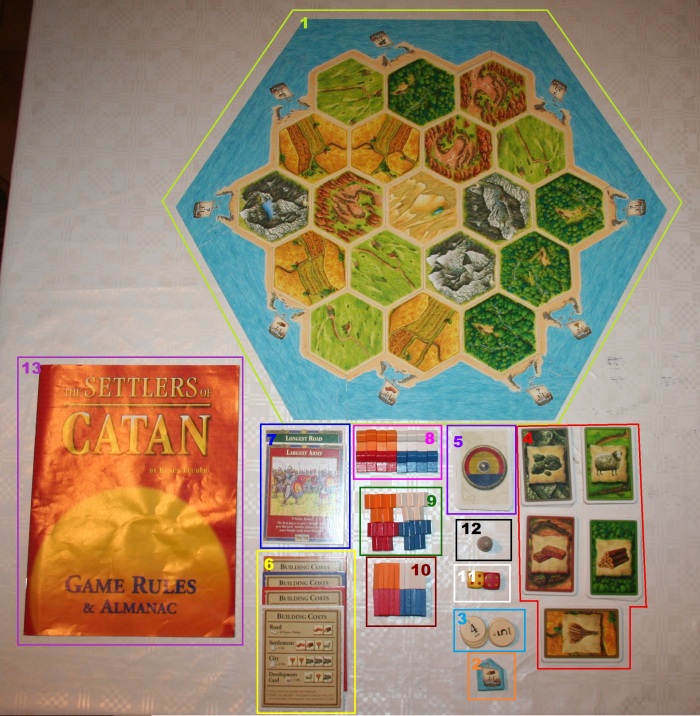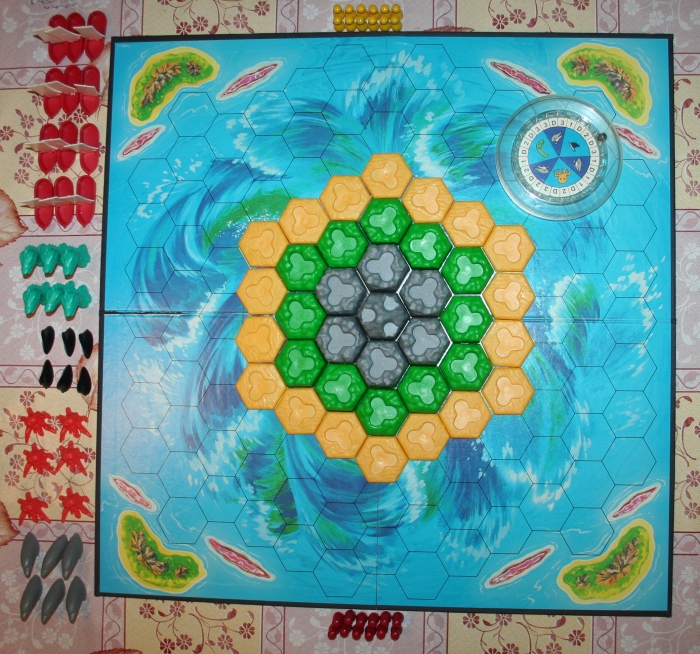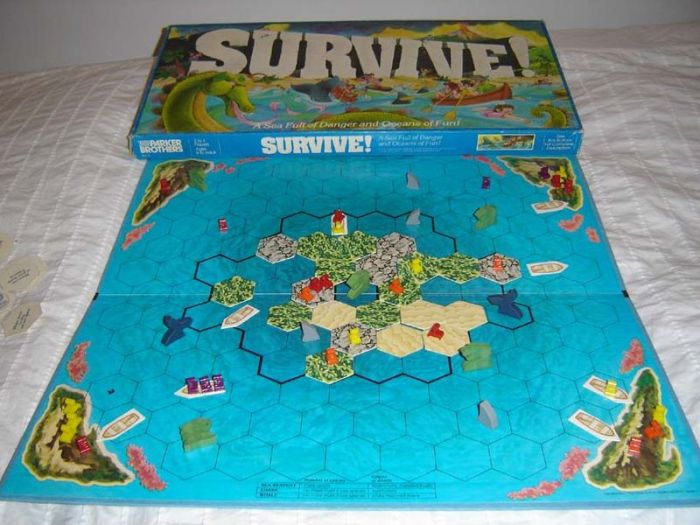NOW SELLING THIS GAME HERE: https://www.ebay.co.uk/itm/Spartacus-A-Game-of-Blood-and-Treachery-Gale-Force-9-Board-Game-Good-Condition/283678724813
Number of Players: 3 – 4
Year of Publication: 2012
Creator: Aaron Dill, John Kovaleski, Sean Sweigart (Designers) and Charles Woods (Artist)
NO! I’m Spartacus:
Spartacus: A Game of Blood and Treachery is a board game based on the TV series Spartacus: Blood and Sand ( which has a mini series prequel and is followed by Spartacus: Vengeance and Spartacus: War of the Damned and proceeded by a not so good Spartacus: Gods of the Arena). To reflect the style of the TV series this is the only game I’ve come across, to date, that has an age rating on it:

And because of this you get cards with things like this written on them:

Now unfortunately, being a big fan of the TV series this review is unlikely to be completely non- biased, I will however do my best to stay objective.
What’s In The Box:

- Game board
- Rules Book
- 4 x House cards
- 62 x Market Cards
- 104 x Intrigue Cards
- 10 x Favor/Injured tokens
- 4 x Champion tokens
- 3 x House betting tokens (per house) and 1 x House marker (per house)
- 1 x Host marker
- 117 x Gold
- 4 x Gladiator figures
- 4 x Turn summary cards
- A lot of Dice (9 x Red, 9 x Black and 8 x Blue)
Playing The Game:
Objective: Be the first to raise your house influence to 12!
Depending on whether you want to play a Quick, Standard or Advanced game you set the starting amount of influence each house has to a different number:
- Quick = 7
- Standard = 4
- Advanced = 1

You then get dealt the starting number of items as dictated by your house card (circled green). So for Solonius that’s 2 Gladiators, 2 Slaves, 1 Guard and 12 Gold. Additionally each player gets one gladiator figure, their 3 house betting tokens and a turn summary card.
Now, every turn of play is made up of four sections:
- Up Keep
- Intrigue Phase
- Market Phase
- Arena Phase
Up Keep:
Up keep consists of three parts:
- Refreshing Cards – Any cards that have been exhausted in the previous round (so are face down) get turn back up so their abilities can be used again.
- Healing Injuries – Attempt to heal any injured gladiators or slaves by performing a healing role – on a role of 4 – 6 they are healed anything less and they stay inured.
- Balancing the Ledgers – You gain one gold for every ready slave you have and you must pay one gold to the bank for every ready gladiator you have – if you cannot pay (or don’t want to) you must discard the card that’s making you pay.
Intrigue Phase:
Intrigue consists of two parts:
- Drawing Cards – At the start of each intrigue phase each player draws three intrigue cards (players all receive three cards simultaneously).
- Playing Schemes/ Foiling Schemes/ Cashing in Cards – Some of the intrigue cards are schemes you can play against another Dominus (Latin word for master), cards that allow you to foil other schemes or get rid of an opponents guards. To play a Scheme you must have the right amount of influence to play it (as listed on the card), if you don’t you can pair with another Dominus to play it by adding your influence together but beware; deals that are made can be easily broken. If someone plays a scheme against you you can foil it by using your guards and performing a dice role or you can play a scheme foiling card that are reactions to schemes and also require that you have the right amount of influence to play it. Finally if you don’t want some of you cards or can’t keep them (as your had size is dictated by the amount of influence you have) you can cash in cards for the amount written on them from the bank.
Market Phase:
This phase is made up of three parts:
- Open Market – At this point anything can be traded for anything for anything else. Except Intrigue cards, which cannot be sold.
- Auction – After open market is over each player conceals their gold in their hand and cards equal to the amount of players playing are drawn face down on to the board. The first card is flipped up; each player decides how much they want to bid for that card and hide it in their hand and hold it out over the board, then together they revel how much they have bid, highest bidder wins. Someone who bids nothing is ignored, but if everyone bids nothing the card is discarded. If there is a tie the two players who are tied place the amount they have already bid on the board and repeat the procedure until one player is victorious. This is then repeated with each card until all cards are sold or discarded.
- Bid for Hosting – This is done in the same way as the bidding for the cards. The person who wins the host bidding gets the Host token and it marks that they control the next phase of the game and choose who will fight who.
Arena Phase:
This phase is made up of six parts:
- Honour to the Host – The player that won the hosting rights in the auction gets +1 influence.
- Hosting the Event – The host then invites two players to take part in the games (they can invite themselves). If a player declines they lose one influence. If they accept they place their gladiator figure in the arena in the starting position then place the card of the gladiator they are fighting, along with any Weapons or Armour they are also using.
- Tribute – The owners of the gladiators are then paid tribute if their gladiators have favour or are champions – +2 gold for each favour token and +6 gold if they are a champion. If they don’t have any favour and are not champions they get nothing.
- Place Wagers – It’s then time to place wagers, you can wager on who will win (competing players can’t wager against themselves) and how they will win (injury or decapitation). Three is the maximum wager on any one wager and the wagers you place are marked by putting you house wager tokens on top of your pile of gold on the wager you have made.

So a bet on combatant one to win returns 1:1 odds so you can double your money. 
A bet on the fight ending in injury returns 2:1 odds so you triple your money. - Combat! – Now the fight begins. Each fighting gladiator has statistics for Attack, Defence and Speed. They are given as many red dice as their attack statistic, as many black dice as their defence statistic and as many blue dice as their speed statistic:

3 Attack = 3 red dice, 2 Defence = 2 black dice and 2 Speed = 2 blue dice. Each player then roles their total amount of speed dice to determine who moves first, the player with the highest total wins and decides who moves first. Your total number of speed dice dictates how many spaces you can move; so if you have two dice you can move two spaces. You can chose to move and then attack or if you’re already adjacent to your enemy you can attack and then move away. Once adjacent you attack by rolling your attack dice while the defender roles their defence dice. You then line the dice up from highest to lowest, opposite each other. Any place where one attack dice is a higher number than the defence dice is a hit and any place where a defence dice is higher than the attack dice is successfully defended. If they’re equal it’s also a successful defence. Where attack die outnumber defence dice any additional roles that have no matching dice count as a hit so long as they are three or above.

Two warriors ready for combat. The dice are your health; so for each hit that is obtained the taker of the hit decides which dice to get rid of, lowering their attack, defence or speed for the next move. All attributes must be reduced to 1 before any can be completely removed. If one is completely removed then the player has yielded, if two are reduced to zero in one attack the player is wounded and if all three are reduced to zero in one attack the player is decapitated.
- Victory and Defeat – The winning Dominus gains one influence. The winning gladiator revives one favour token, if it’s his third favour token he becomes a Champion. Wagers are then settled with the bank. If the loser was not decapitated the host of the games decides if he lives or dies with the thumbs up or down signal. To kill a loser who has favour will cost the hosting Dominus 1 influence per favour token and champions cannot be killed.
After all this the turn phases are repeated unless one player has a full 12 influence at this point, then they’re the winner! If they have reached 12 influence before this point they are not yet the winner as they can still lose influence before the turn of play is over.
Strategy:
- MONEY IS POWER! Like in real life. If you are a broke Lanista (trainer of Gladiators) then you are a rather useless Lanista.
- UNDERSTAND WORTH! Linked to the first point, knowing what/how much to bid for something in this game is everything. Knowing what you need and what’s not worth buying (at that time) will be the key to winning and losing.
- HOST THE MOST! Bidding to be the host is always worth it, not only does it automatically give you influence you then have control too.
- KNOW YOUR FRIENDS! While this is a rather back stab-y game it’s important to know the people you’re playing with and understand when they’re likely to stick with you and at what point they will abandon you and leave you to be eaten by dogs.
- KEEP THINGS IN PERSPECTIVE! With such a large turn phase to the game it’s very easy to get caught up in just one round or one arena match and forget about the bigger picture and larger aim. Everything you do should be in aid of the bigger picture not just to get back at another player or just because you want to see a fight between two cool Gladiators.
History and Interesting Things:
While the board game itself does not have much notable history (at least nothing I can find) the historical events it’s based (very loosely around) do so that’s more what this section is going to contain.
- The board game was published in 2012, before the airing of the final season of the TV show, by A1 Games, Battlefront Miniatures Ltd, Gale Force Nine, LLC, Heidelberger Spieleverlag, Marabunta and Zvezda.
- The board game is only based on the first season of the TV show Spartacus: Blood and Sand, it being the only season in which Spartacus is a Gladiator rather than a rebel.
- The TV series is a re-imagining of the 1960 film Spartacus directed by Stanley Kubrick and starring Kirk Douglas.
- However both the TV show and the film are based (loosely) around the historical Third Servile War of the Roman Republic.
- While historical facts on the war are highly debated it is often interpreted as a rebellion of oppressed people rising up against a slave owning oligarchy.
- Historically Spartacus (the man) is supposed to have lived from 109 BC – 71 BC. The characters Crixus,Oenomaus, Castus and Gannicus, are also historically verified people who assisted in the uprising.
- He was born a Thracian and supposedly died on the Battlefield near to Petelia (modern-day Strongoli, Calabria, Italy) as depicted in the TV show and film (probably without the “I’m Spartacus” fiasco).
- This being Appian also that his body was never found.
- 6000 survivors of the battle where crucified alongside the Appian Way from Rome to Capua as depicted in the final episode of the TV show with the crucifixion of Gannicus.
- Andy Whitfield who played Spartacus in the first season Spartacus: Blood and Sand (who’s face should be on the front of the game box rather than his replacements Liam McIntyre) sadly died on September the 11 2011 of on-Hodgkin lymphoma and the series was literally less than half as good without him.

To Conclude:
While my obvious like for the TV show has made this review at least slightly biased I would still maintain this game is a good game by anyone’s standards. It is, however perhaps a touch complex and drawn out. For example; cancelled down version of just the gladiator battles would have made quite a good game just in itself. So this game is primarily for the patient and those who are naturally enthusiastic about games not for those who think monopoly is the epitome of (board) gaming.
Further more it’s always nice to see a box that’s well designed unlike the Pirate of the Caribbean edition of Buccaneer! and Conquest of the Empire:

Yes I do think rate the box is going to have to become a permanent part of our posts.













































